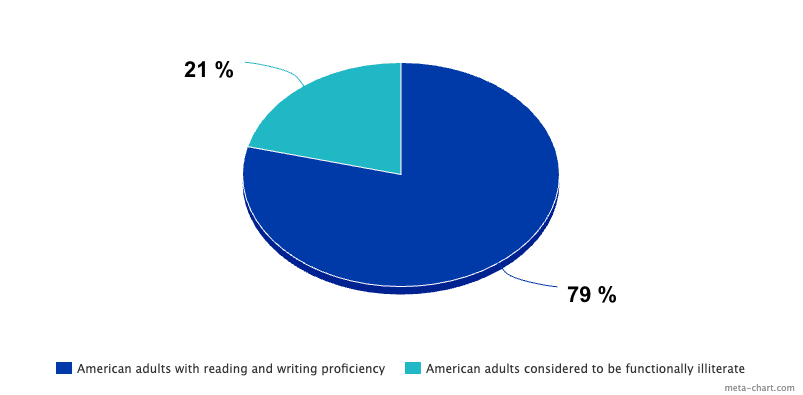
Adult literacy remains a foundational pillar for personal advancement and economic opportunity in the United States. While millions of adults continue to face challenges with basic reading and comprehension, improving literacy skills is closely linked to better employment prospects, higher earnings, and stronger family and community outcomes.
A recent study from OECD showed literacy and numeracy scores in decline for adults in the United States. In this article, we’ll review common signs of low literacy and then examine statistics on adult literacy.
6 Signs of Low Literacy
Low literacy isn’t a reflection of intelligence; it’s about the everyday challenges that can make reading and understanding information difficult. These signs aren’t failures, but opportunities for growth and support. Noticing them is the first step toward positive change.
- Struggles with Reading Tasks: Has trouble reading forms, directions, or multi-step instructions
- Avoids Reading Aloud: Feels anxious or tired when asked to read in front of others
- Poor Comprehension: Can’t easily summarize or recall what was just read
- Relies on Memory or Guessing: Skips words or guesses instead of reading smoothly
- Everyday Hesitation: Avoids or needs help with menus, labels, or workplace materials
- Shame or Embarrassment: Feels embarrassed or hides reading struggles from others
Apps & Resources to Explore
A variety of digital tools and community programs make reading practice flexible, accessible, and supportive for adult learners. Apps focused on adult literacy and real-world reading tasks like Learning Upgrade can help you build skills at your own pace, while online programs and local libraries often provide free or low-cost classes, workshops, and access to technology.
Whether you prefer learning through an app, joining a class, or practicing with a peer or tutor, the key is consistency. Choose a resource that fits your schedule and feels comfortable. Taking just 10–15 minutes a day to practice can make a big difference.

National Adult Literacy Statistics
Adult literacy levels in the U.S. reveal a deep divide in reading and comprehension skills across the population. The latest data shows that more than half of adults read below a sixth-grade level, with millions struggling to complete everyday reading tasks. These statistics underscore the urgent need for nationwide support and accessible programs. Strengthening adult literacy is essential to individual success and national progress.
- In 2023, 28% of U.S. adults scored at or below Level 1 literacy, indicating significant difficulty with everyday reading tasks.
- In 2023, 29% of U.S. adults scored at Level 2 literacy, showing basic reading proficiency but challenges with complex texts.
- In 2023, 44% of U.S. adults scored at Level 3 literacy or above, indicating strong reading and comprehension skills.
- About 130 million U.S. adults (54% of those aged 16–74) read below a sixth-grade level, according to modeled estimates.
- Approximately 45 million U.S. adults are functionally illiterate, reading below a fifth-grade level.
- 21% of U.S. adults are classified as functionally illiterate, unable to complete basic reading tasks.
- The average American reads at a 7th- to 8th-grade level.
- Adults scoring in the lowest literacy levels (Level 1 or below) increased by 9 percentage points between 2017 and 2023.
- U.S. adults’ average literacy scores declined by 12 points from 2017 to 2023, according to the latest PIAAC data.
- In 2023, 46% of U.S. adults had a literacy proficiency at or above Level 3.
Social Factors Affecting Literacy
Literacy is shaped by a range of social and demographic factors, from birthplace and language proficiency to incarceration rates and parental education. Disparities are especially pronounced among U.S.-born adults and underserved communities. Children raised in low-literacy households often face significant academic challenges. Understanding these contributing factors helps shape more effective solutions for lasting change.
- Two-thirds of U.S. adults with low literacy skills are U.S.-born, while 34% are foreign-born.
- White and Hispanic adults represent the largest segments of those with low literacy skills, at 35% and 34%, respectively.
- Three out of four (75%) state-incarcerated individuals did not complete high school or are classified as low literate.
- Incarcerated individuals who participate in correctional education programs are 43% less likely to return to prison.
- Only 53% of U.S. immigrants are proficient English speakers.
- Three out of four people on welfare have the lowest two levels of literacy.
- One in five (20%) Americans read below the level needed to earn a living wage.
- Half of the unemployed between ages 16 and 21 cannot read well enough to be considered functionally literate.
- Nearly 80% of those who live in poverty read at Level 2 or below.
- Children surrounded by adults with low literacy rates are 72% more likely to have a low reading level in school.
- A mother’s reading skill is the greatest determinant of her children’s future academic success, outweighing other factors such as neighborhood and family income.
- More than a third (34%) of U.S. fourth graders have a reading level lower than the basic level.
- 27% of eighth-grade students have a reading level below the basic level.
- Nearly four out of ten (39%) of eighth-grade students read below the proficient level.
- 44% of American adults do not read a book in a year.

1 in 5 U.S. adults are considered functionally illiterate, unable to complete basic reading tasks.
The Economic Impact of Literacy
Low literacy doesn’t just affect individuals, it has a profound impact on the U.S. economy. Billions of dollars are lost each year due to reduced productivity, increased healthcare costs, and limited employment opportunities. Investments in literacy programs have the potential to boost GDP, improve lives, and reduce long-term public spending. Addressing this gap is both a moral and economic imperative.
- Low adult literacy is estimated to cost the U.S. economy up to $2.2 trillion annually in lost productivity and earnings.
- Between $106 billion and $238 billion in health care costs each year are linked to low adult literacy skills.
- Illiteracy costs American taxpayers an estimated $20 billion each year.
- School dropouts cost the nation $240 billion in social service expenditures and lost tax revenues.
- Bringing all adults to Level 3 literacy could boost U.S. GDP by 10%.

Literacy Program Access
Although adult literacy programs exist, access remains a significant barrier. A vast majority of adults with low literacy skills are unaware of or unable to enroll in available programs. Limited funding, volunteer shortages, and long waitlists hinder progress. Expanding outreach and support for adult learners is essential to closing the literacy gap.
- Less than 10% of adults with low literacy skills are enrolled in an adult education program.
- Four out of five (80%) adults with low skills said they don’t feel knowledgeable about adult education programs, making it less likely they will seek help.
- 51% of adult literacy programs report putting students on a waiting list due to demand exceeding program capacity.
- 63% of adult literacy programs have waiting lists due to insufficient funding and volunteers.
- In 2019–2020, 1.1 million adults were enrolled in federally funded adult education and literacy programs, down from 2.78 million in 2001–2002.
- Only a small percentage of those in need receive adult literacy services, and many programs have waiting lists due to high demand.
- Federal adult education funding is allocated based on the percentage of people without a high school diploma in a state.
- 29% of adult basic literacy students enter a program reading at or below a third-grade level.
- 48 million adults in the U.S. cannot read above a third-grade level.

State-by-State Adult Literacy Statistics
Literacy rates vary widely by state, influenced by education funding, public policy, and access to services. While states like New Hampshire and Minnesota lead in adult literacy, others face more substantial challenges. These disparities highlight the importance of localized strategies and targeted investment. Improving literacy requires understanding each region’s unique needs and strengths.
- Minnesota has one of the highest adult literacy rates, with 57% of adults scoring at or above Level 3 proficiency.
- New Hampshire has the highest state literacy rate at 94.2%.
- California has the lowest adult literacy rate among U.S. states at 76.9%.
- In New Mexico, 29% of adults scored at or below Level 1 proficiency, compared to 28% in California and Texas.
- State funding for adult education varies widely, with New Mexico spending $6.2 million and Minnesota $49.8 million in 2019–2020.

Literacy Trends Over Time
U.S. adult literacy rates have declined in recent years, with more adults scoring at or below the lowest proficiency levels. This downward trend has been amplified by pandemic-related disruptions to education and widening performance gaps. Recognizing these patterns helps inform future efforts. Rebuilding literacy skills across all age groups is critical for long-term recovery and growth.
- The percentage of U.S. adults scoring at or below Level 1 increased from 19% in 2017 to 28% in 2023.
- The gap between the highest- and lowest-performing adults widened between 2017 and 2023, with top scorers remaining steady while low scorers increased.
- The pandemic is considered a major reason for recent declines in literacy rates, as students lost significant instructional time.
- The average literacy score of U.S. adults declined by 12 points from 2017 to 2023, according to PIAAC data.
- Adults at Level 1 or below can comprehend simple sentences and short paragraphs but struggle with multi-step instructions or complex texts.
Sources
- https://nces.ed.gov/whatsnew/press_releases/12_10_2024.asp
- https://www.apmresearchlab.org/10x-adult-literacy
- https://www.babbel.com/en/magazine/functional-illiteracy
- https://www.proliteracy.org/wp-content/uploads/2023/09/2023-PL-AdultBasicEducation-FactSheet-2467.pdf
- https://nationalcoalitionforliteracy.org/ncl-2024-year-in-review/
- https://www.thepolicycircle.org/briefs/literacy/
- https://en.wikipedia.org/wiki/Literacy_in_the_United_States
- https://www.nbcnews.com/data-graphics/survey-growing-number-us-adults-lack-literacy-skills-rcna183498
- https://www.proliteracy.org/resources/adult-literacy-facts/
- https://literacybuffalo.org/2025/01/23/adult-literacy-rates-are-falling-new-literacy-study-shows-big-problems/
- https://nces.ed.gov/surveys/piaac/measure.asp

This content has been reviewed and approved by the National University Editorial Advisory Board. Learn more about our editorial process.